
Research Article
Austin J Biotechnol Bioeng. 2017; 4(1): 1072.
Physico-Chemical, Gas Chromatography-Mass Spectrometry (GC-MS) Analysis and Soap Production from Thervetia Peruviana Seed Oil
Warra AA*
Kebbi State University of Science & Technology, Nigeria
*Corresponding author: Aliyu Ahmad Warra, Kebbi State University of Science & Technology, Nigeria
Received: December 29, 2016; Accepted: March 14, 2017; Published: March 23, 2017
Abstract
Thevetia peruviana plant known in Hausa as ‘Gamboje’ wasfound to be a plant of cosmetic importance. The hexane extract of the seed oil was Physicochemically analyzed, fatty acid compostion qualitatively determined using GCMS. The oil yield was 56.50 ± 0.10 (%), the colour of the oil was golden yellow. The results of the physic-chemical analysis revealed the following; Acid value 14.03 ± 0.01mgKOH/g, iodine value 177.66 ± 0.02gI2/100g,Peroxide value 12.40 ± 0.10meq H2O2, Saponification value 227.21 ± 0.01mgKOH/g, Relative density 0.92 ±0.01 (g/cm3), Refractive index1.46 ± 0.01. The fatty acids detected were palmitic acid, non adecanoic acid, steric acid, oleic acid, hepta draconic acid, linolelaidic acid, steatotic acid, 11,14- Eicosadienoic acid, erucic acid and brassidic acid. The prepared thervetia oil soap produce white colour and slightly soluble in water, pH measured was 9.75 ± 0.05 and Foam height was 80.00 ± 1.00 (cm³). The results were in favour of utilization of the seed oil in cosmetics.
Keywords: Thervetia; Seed oil; Physico-chemical; GC-MS; Saponification
Introduction
Thevetia peruviana is an evergreen tropical shrub or small tree. Its leaves are willow-like, linear-lanceolate, and glossy green in colour [1]. Thevetia peruviana belonging to family Apocynaceae and commonly called as yellow oleander or Pila kanheris an important medicinal plant. This plant is native of central & South America, but now frequently grown throughout the tropical and shrub or small tree that bears yellow or orange-yellow, trumpet like flowers and its fruit is deep red/black in color enhancing a large seed that bears some resemblance to a Chinese “ lucky nut”. Thevetia peruviana plant tolerates most soil and is drought tolerant and. It is also useful as a landscaping plant in warmer climates as it does not need much maintenance [2]. Thevetia peruviana are found distributed throughout tropical parts of India. Their leaves are used as cardio tonic and diuretic. Flowers of Plant Thevetia peruviana were reported to possess good medicinal value in traditional system of medicine [3]. The Yellow oleander (Thevetia peruviana), is a potential oil seed and a good alternative source of nutrition for food and animal feeds [4].
The seeds, flowers, leaves, barks, and roots of the plant have been extensively studied for their biochemical activity [5]. A comprehensive account of its chemical constituents and the pharmacological activities are reported, many recent findings of importance with regards to this plant. A wide range of secondary metabolites such as Enolides, Flavones; Thevetoside; Theveside; Glycosides; and Flavanones have been isolated from this plant, exhibiting diverse and extreme array of biological activities. Extracts from seeds, flowers, leaves, and bark of this plant, possess useful pharmacological activities. Thevetia peruviana is a well-studied plant of medicinal value. It has scientifically proven to show anti-microbial activity from the oil of the plant that contains flavonoids; anti-inflammatory activity from the extracts of the flowers that contain quercetin, kaempferol and quercetin-7- O-galactoside; strong Toxicity was reported from leaf, stem and roots of Thevetia peruviana (Pers) Schum [6]. Toxicological and Nutritional Evaluations of Milk Bush (Thevetia neriifolia) Seed Oil-Based Diet in Albino Rats was also reported [7]. Immuno modulatory activity due to Kaempferol; β-sisterol present in the bark of the plant shows presence of anti-fungal and anti-bacterial activity and thieve folic isolated from seeds showed anti-cancer activity and cardio tonic activity [8]. Oil is extracted from the seeds for industrial applications, optimum dilution ratio and water temperature for extracting oil from Thevetia nuts was reported [9]. Yield, quality, kinetics and thermodynamics studies on extraction of Thevetia peruviana oil from its oil bearing seeds was also reported [10]. Standardization and Antibacterial Activity of Thevetia neriifolia Juss, was reported [11]. Seed contains about 64 percent of non-edible oil in its oily kernel and this oil can be used for various purposes such as biofuel and bio-oil; making of paints, insecticides, cosmetics, lubricants and cooling oil in electrical transformers. The cakes obtained after oil extraction are incorporated on the field as manure [12]. Determination of the Edibility of Thevita Peruviana Seed Oil Using GC-MS, FTIR and UV-VIS Analysis was reported [13]. Thevetia peruviana has been found to contain anti-bacterial activity. The leaves of Thevetia peruviana are used to toothache due to caries. Studies on Antimicrobial and Antioxidant Efficacy of Thevetia neriifolia, Juss Leaf Extracts against Human Skin Pathogens Thevetia was reported, the authors also reported Detection and Quantification of Cardio tonic Drug Peruvoside Using HPTLC from Thevetia neriifolia Juss Seed Extracts [14, 15]. Spectrophotometric screening of potent bactericidal property of Thevetia peruviana Schum. Leaf and fruit rind extracts on clinical and plant pathogens was reported [16]. It is used in Antirheumatic and decongestant. Its branches are used for febrifuge and purge [17]. A Nigerian case study of the potential of Oleander (Thevetia peruviana) in African agricultural and industrial development was reported [18]. Analysis of Fatty Acid Composition of Thevetia peruviana and Hura crepitans Seed oils using GC-FID was carried out [19]. Some researchers centred on biofuel application of Thevetia peruviana (Schum) seed oil, Production of Biodiesel from Yellow Oleander (Thevetia peruvian) Oil and its Biodegradability was reported [20]. Characterization of Oil and Biodiesel Produced from Thevetia peruviana (Yellow Oleander) Seeds was reported [21]. Assessment and Optimization of Energy use of Yellow Oleander (Thevetia Peruviana) for Biodiesel Blends in Nigeria was also reported [22]. Yellow Oleander (Thevetia Peruviana) oil has been extracted and analyzed relevant to lubrication [23]. In comparison with Jatropha cruces seed oils Thevetia peruviana was reported as feedstock for Grease production [24]. Synthesis and Characterization of Vegetable Oil-Based Polyol from (Thevetia Neriifolia) Seed Oil was reported [25]. The oil was reportedly useful in metal soap preparations, synthesis and characterization of copper metal soaps from Thevetia peruviana seed oil was reported [26]. Thevetia peruviana (Schum) seed oil was used to make a herbal lotion for skincare [27]. This research is aimed at quality characterization of oil and analysis of Soap Produced from Hexane Extract of Thevetia peruviana seed oil.
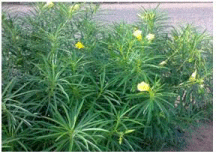
Figure 1: Thevetia plant.
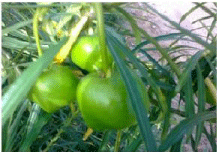
Figure 2: Thevetia fresh fruits.
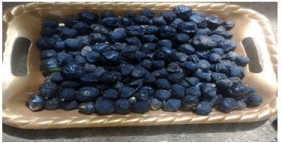
Figure 3: Thevetia dried fruits.
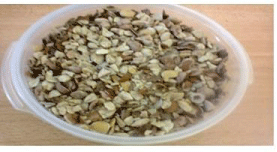
Figure 4: Thevetia deshelled seeds.
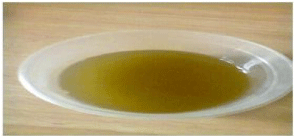
Figure 5: Thevetia seed oil.
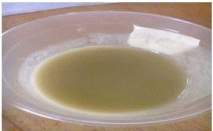
Figure 6: Freshly prepared Thevetia seed oil soap.
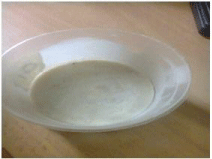
Figure 7: Cured Thevetia seed oil soap.
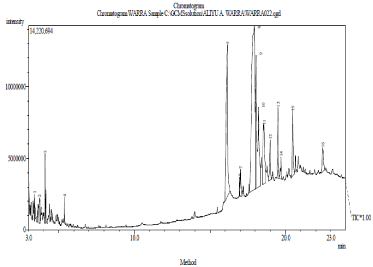
Figure 8: Typical GC-MS total ionic chromatogram (TIC) of thevetia
peruviana seed oil.
Materials and Methods
Sample collection, identification and preparation
Thevetia peruviana (Schum) seeds were obtained at the premises of Kebbi State University of Science and Technology, Kebbi State, Nigeria. The taxonomic identification was authenticated by a Botanist at Biological Sciences Department, Bayero University, Kano; Nigeria. Voucher Number BUKHAN 125 of the specimen kept at Herbarium was compared. The dried seeds were deshelled and crushed into powder using mortar and pestle and were stored in a plastic container prior to oil extraction.
Oil Extraction procedure
The hexane extract was obtained by complete extraction using the Sox let extractor (GG-17, SHUNIU). The 50 g of each powdered kernel sample was put into a porous thimble and placed in a Sox let extractor, using 150 cm3 of n-hexane (with boiling point of 40- 60°C) as extracting solvent for 6 hours repeatedly until required quantity was obtained. The oil was obtained after evaporation using Water bath at 70°C to remove the excess solvent from the extracted oil. The oil was then stored in refrigerator for subsequent physicochemical analysis.
Percentage yield
The oil which was recovered by complete distilling of most of the solvent on a heating mantle was transferred to a beaker. The beaker was then placed over water bath for complete evaporation of solvent for about 2 hours and volume of the oil was recorded and expressed as oil content (%) in line with literature report [28].
Determination of color
The color of the oil samples was determined by observation using several independent competent individuals. Oil colour was correlated using colour charts [29].
Determination of density
This was performed according to literature report [30]. The 10ml of the oil was measured in a pre-weighed measuring cylinder. The weight of the cylinder and oil was measured; the weight of the oil was then obtained by subtracting the weight of the cylinder from the weight of the oil and cylinder. The density of the oil was obtained using equation below.
Density of oil = (W1-Wo)/(Vo)
where W1 = weight of empty measuring cylinder + oil. Wo = weight of measuring cylinder, Vo = volume of oil used.
Physico-chemical analysis
The Physico- chemical analysis of the Thevetia peruviana seed oil was carried out using the methods reported [31-33].
Gc-Ms Analysis
The analysis of the fatty acids in the Thevetia peruviana seed oil sample was done at National Institute of Chemical Technology (NARICT), Zaria, Nigeria, a Shimadzu QP2010 plus series gas chromatography coupled with Shimadzu QP2010 plus mass spectroscopy detector (GCMS).
System was used. The temperature programmed was set up from 70°C to 280°C. Helium gas was used as carrier gas. The injection volume was 2 μl with injection temperature of 250°C and a column flow of 1.80 mL/min for the GC. For the mass spectroscopy ACQ mode scanner with scan range of 30-700 amu at the speed of 1478 was used. The mass spectra were compared with the NIST05 mass spectral library [33].
Preparation and analysis thevetia peruviana seed oil soap
Saponification procedure: As reported in literature [34]. 200 grams of sodium hydroxide pellets was dissolved in 1000cm3 volumetric flask and the volume made to the mark with distilled water. The required quantity of alkaline solution was mixed with Thevetia seed oil (ratio 1:1 v/v). The oil was warmed gently and poured into the beaker followed by the alkali solution to form an intimate mix and then stirred frequently for 7 minutes using stirring rod until reaction reached equilibrium. The saponification mixture was then poured into mould and allowed to dry (cure) for 24 hours.
PH Determination
The PH was determined using pH meter (350 JENWAY Model). A 5g of the soap shavings were weighed and dissolved with distilled water in a 100ml volumetric flask. The electrode of the pH meter was inserted into the solution of the soap and the pH reading was recorded [35].
Foam ability test
A 2g of the soap was added to a 500 cm³ measuring cylinder containing 100 cm³ of distilled water. The mixture was shaken vigorously so as to generate foams. After shaking for some time, the cylinder was allowed to stand for 10 minutes. The height of the foam in the solution was measured and recorded [36] (Figures 1-8 and Tables 1-3).
Parameters
Values
Oil yield (%)
56.50± 0.10
Colour
Golden yellow
Iodine value gI2/100g
14.03± 0.01
Iodine value gI2/100g
177.66± 0.02
Peroxide value meq H2O21
2.40±0.10
Saponification value mgKOH/g
227.21± 0.01
Relative density (g/cm3)
0.92±0.01
Refractive index
1.46±0.01
Values are expressed as mean and ± standard deviation of triplicate determinations
Table 1: Physicochemical properties of thevetia peruviana seed oil.
S/N
Name of fatty acid
MF
MW
RI
SI% to T.C.
1
Palmitic acid
C16H32O2
256
1968
92
2
Nonadecanoic acid
C19H38O2
298
2266
90
3
Stearic acid
C18H36O2
284
2167
89
4
Oleic acid
C18H34O2
282
2175
90
5
Heptadecanoic acid
C17H34O2
270
2067
91
6
Linolelaidicc acid
C19H34O2
294
2093
90
7
Stearolicacid
C18H32O2
280
2184
90
8
11-14-Eicosadienoic acid
C21H38O2
312
2292
9
Erucic acid
C22H42O2
338
2572
88
10
Brassidic acid
C22H42O2
338
2572
87
Note: S/N: Serial Number; MF: Molecular Formula; MW: Molecular Weight; RI: Retention Index SI%: Similarity Index; TC: Target Compound.
Table 2: Major fatty acids derived from hexane extract of Thevetia peruviana seed oil.
Parameters
Values/Observation
pH
9.75± 0.05
Foam height (cm³)
80.00± 1.00
Solubility in water
Slightly soluble
Color
White
Values are expressed as mean ± standard deviation of triplicate determinations
Table 3: Physicochemical characteristics of Thevetia peruviana seed oil soap.
Discussion
The oil yield was 56.50 ± 0.10 (%), higher than 50.42 ± 0.01 reported for canary melon seed oil [37] and 19.23 ± 0.07% reported for Ipomoea carnea ssp. fistulosa L seed oil [38] closer to 56.30 ± 2.35% reported for Terminal Catappa L “Congo-Brazzaville” seed oil [39]. recommended for cosmetic uses. The colour of the oil was golden yellow. Oil whose colour is brighter, transparent and close to its natural color is attractive to many consumers [40]. For the Physicochemical analysis results; Acid value of 14.03 ± 0.01 mg KOH/g was obtained, the value is higher than 2.39 ± 0.065 reported for castor seed oil [41] and 12.97 ± 0.01 reported value for Neocarya macrophylla seed oil [42] lower than 27.09 ± 2.30 reported for Hura crepitan seed oil [43], 31.88 reported for Calophyllum inophyllum Linn seed oil [44]. Lower acid value makes oil suitable for soap production. Iodine value of 177.66 ± 0.02 gI2/100g was obtained the value is greater than 100 which is within a range of semi-drying oils consisting predominately polyunsaturated fatty acids mainly oleic and linoleic fatty acids. This class of oils whose iodine value is between 100-150 possesses the property of absorbing oxygen on exposure to the atmosphere; though do not do so sufficiently to qualify them as drying oils. They become thicken and remain sticky but do not form a hard dry film. They are used in the production of margarine and soap [45]. Peroxide value was 12.40 ± 0.10 meq H2O2higher than 8.4 ± 1.98 reported for terubok oil [46] lower than 35.6 reported for wild Corchorus olitorius seed oil [47]. The peroxide value is used as an indicator of deterioration of oils. Fresh oils have values less than 10 meq Kg-1. Values between 20 and 40 result to rancid taste. High values can be reduced by alkaline refining [48]. Saponification value of 227.21 ± 0.01mgKOH/g was obtained which is higher than 203.00 ± 0.00 and 218.52 ± 0.01 reported for white and brown sesame seed (Sesamun indium L.) oils respectively [49] indicating high saponification value and suitability for soap making, Relative density was 0.92±0.01 (g/cm3), lower than 0.93± 0.00 reported for Blighia sapida fruit oil [50], higher than 0.8987 reported for poppy oil [51]. Refractive index was 1.46 ± 0.01 higher than 1.44 ± 0.00 reported for onion seed oil [52] both indicating high purity [53]. The fatty acids detected were palmitic acid used in concentration in cosmetics [54]. Non adecanoic acid, a 19-carbon long-chain saturated fatty acid found in fats and vegetable oils. [55]. Steric acid mainly used in the production of detergents, soaps, and cosmetics such as shampoos and shaving cream products [56]. Oleic acid safer for use at requires concentration in the preparation of oleates and lotions, and as a pharmaceutical solvent [57]. Heptadrcanoic acid or margaric acid is a saturated fatty acid. Linolelaidic was also found. Steatotic acid was detected, a fatty acid which supports the growth of anaerobic yeast [58] 11, 14- Eicosadienoic acid was also found. Erucic acid was found, products produced using erucic acid include cosmetics [59]. Brassidic acid was another fatty acid detected a trans-isomer of erucic acid. The prepared thervetia oil soap produce white colour and slightly soluble in water, pH measured was 9.75 ± 0.05 lower than 10.11 reported for Jatropha seed oil soap [60], the more closer the soap is to 7.5-8.0 (skin friendly) pH the better and safer. Foam height was 80.00 ± 1.00 (cm³) lower than 5.4 reported for Jatropha seed oil soap [60] It is of interesting to note that foam generation is important as it is attractive to the consumer and is therefore considered as a parameter in evaluating soaps and detergents [61]. The results were in favor of utilization of the seed oil in cosmetic preparations.
References
- Naz S, Agrawal S. Evaluation of antimicrobial activity of ethanolic extract of Thevetia peruviana KANER Leaves. Indian J Sci. 2015; 51: 017-020.
- Rajbhar N, Kumar A. Pharmacological Importance of Thevetia peruviana. Int J Pharm Chem Sci. 2014; 31: 260-263.
- Deshmukh AS. Pharmacogenetic and preliminary physiochemical investigations of plant Thevetia peruviana leave and flowers. Int J Pharm.110: 650-653.
- Shieunda OS. Evaluation of Nuitritional Properties of Yellow Oleander Thevetia Peruviana Seeds in Kenya. Food Sci Quality Manage. 2013; 22: 84-98.
- Save SA, Lokhande RS, Chowdhary AS. Thevetia peruviana: |the Good Luck tree. Innovations Pharma. Pharmacotherapy. 2015; 33: 586-606.
- Mollah JU, Islam W. Toxicity of Thevetia peruviana Pers Schum. Extract to Adults of Callosobruchus maculatus F Coleoptera Bruchidae J Agric Rural Dev. 2007; 51: 105-109.
- Nwozo SO, Ajayi IA, Iorliam EB. Toxicological and Nutritional Evaluations of Milk Bush Thevetia neriifolia Seed Oil-Based Diet in Albino Rats. J Nat Sci Res. 2014; 23: 131-138.
- Save SA, Padmanabhan U, Kothari ST, Lokhande RS, Chowdhary AS. Chemical and pharmacological study of the twigs of Thevetia peruviana plant and its bio-activity profiles. Int J Res Eng Appl Sci. 2015; 56: 128-133.
- Raphael OD and Fashanu OO. Optimum dilution ratio and water temperature for extracting oil from thevetia nuts. Int J Agric PolicyRes. 2015; 34: 185-191.
- Jabar JM, Lajide L, Adetuyi AO, Owolabi BJ, Bakare IO, Abayomi TG, et al. Yield, quality, kinetics and thermodynamics studies on extraction of Thevetia peruviana oil from its oil bearing seeds. J Cereals Oilseeds. 2015; 65: 24-30.
- Gangwar AG, Ghosh AK, Saxena V. Standardization & Antibacterial Activity of Thevetia neriifolia Juss. Int J Herbal Med. 2013; 3: 25-28.
- Odewole MM, Ajibade RO. Fabrication and Performance Evaluation of a Thevetia Nut Cracking Machine Nigerian. J Technol Dev. 2015; 121: 12-17.
- Ofoegbu O, Kelle IH. Determination of the Edibility of Thevita Peruviana Seed Oil Using GC-MS, FTIR and UV-VIS Analysis. J BasicAppl Sci Res. 2013; 312: 385-391.
- Nesy EA, Mathew L. Studies on Antimicrobial and Antioxidant Efficacy of Thevetia neriifolia, Juss Leaf Extracts against Human Skin Pathogens. Int J of Pharma Sci Drug Res. 2014; 62: 164-168.
- Nesy EA, Mathew L. Detection and Quantification of Cardiotonic Drug Peruvoside Using HPTLC from Thevetia neriifolia, Juss Seed Extracts. Int J Pharma Sci Invention. 2014; 34: 11-16.
- Rahman N, Mahmood R, Rahman H, Haris M. Spectrophotometric screening of potent bactericidal property of thevetia peruviana schum. leaf and fruit rind extracts on clinical and plant pathogens. Int J Appl Sci Biotechnol. 2014; 24: 451-459.
- Thilagavathi R, Helen V, Kavitha P, Venkatraman BR. Isolation Characterization and Anti-Inflammatory Property of Thevetia Peruviana. E-J Chem. 2010; 74: 1584-1590.
- Usman LA, Oluwaniyi OO, IbiyemI SA, Muhammad NO, Ameen OM. The potential of Oleander Thevetia peruviana in African agricultural and industrial development: a case study of Nigeria. J Appl Biosci. 2009; 24: 1477-1487.
- Alabi KA, Lajide L, Owolabi BJ. Analysis of Fatty Acid Composition of Thevetia peruviana and Hura crepitans Seed oils using GC-FID. Fountain J Nat Appl Sci. 2013; 2: 32-37.
- Yarkasuwa CI, Wilsonand D, Michael E. Production of Biodiesel from Yellow Oleander Thevetia peruvian Oil and its Biodegradability J Korean Chem Soc. 2013; 573 377-381.
- Ana Godson REE, Udofia BG. Characterization of Oil and Biodiesel Produced from Thevetia peruviana Yellow Oleander Seeds. Int J Sustainable and Green Energy. 2015; 44: 150-158.
- Adamu FA, Jahun BG, Daniel C. Assessment and Optimization of Energy use of Yellow Oleander Thevetia Peruviana for Biodiesel Blends in Nigeria. Int J Sci Res. 2014; 411: 1277-1280.
- Oseni MI, Agbi BE, Ogamenyi IO. Extraction and Analysis of Chemo-physical Properties of Yellow Oleander Oil as Lubricant. British J Appl Sci Technol. 2014; 46: 1020-1029.
- Olisakwe HC, Tuleun LT, Eloka-Eboka EC. Comparative Study of Thevetia peruviana and Jatropha curcas seed oils as feedstock for Grease production. Int J Eng Res Appl. 2011; 13: 793-806.
- Ikyenge BA, Ageh JT, Anhwange BA, Nyiatagher DT. Synthesis and Characterization of Vegetable Oil-Based Polyol from Thevetia Nerrifolia Seed Oil. Int J Modern Org Chem. 2012; 11: 55-59.
- Owolabi JB, Alabi KA, Lajide L. Synthesis and characterization of copper metal soaps from Thevetia peruviana and Hura crepitans seed oils. Sci Res Essays. 2015; 1023: 649-654.
- Kareru PG, Keriko JM, Kenji GM, Thiong’o GT, Gachanja AN, Mukiira HN. Antimicrobial activities of skincare preparations from plant extracts. Afr J Traditional Comp Alt Med. 2010; 7: 214-218.
- Pant KS, Koshla V, Kumar D, Gairola G. Seed oilcontent variation in Jatropha Curcas L indifferent altitudinal ranges and site conditions in HP India Lyonia. 2006; 112: 31-34.
- Okolie PN, Uaboi-Egbenni PO, Ajekwene AE. Extraction and Quality Evaluation of Sandbox Tree Seed Hura crepitan Oil. World J Agric Sci. 2012; 8: 359-365.
- John K. Analytical Chemistry for Technicians 3rd Edn CRC Press LLC.Boca Raton. Florida. 2003.
- Bassir O. Handbook of Practical Biochemistry. Ibadan University Press. Nigeria.1978.
- AOAC. Official Methods of Analysis of the Association of Official Analytical Chemists. 16th Edn Gaithersburg USA.1998.
- Akpan UG, Jimoh A, Mohammed AD. Extraction and characterization and h Modification of Castor seed. Leonardo J Sci. 2006; 8: 43-52.
- NIST.GC-MS NIST Library Information Manual.2012.
- Warra AA. The Science and Technology of soap Production Utilizing Indigenous Raw Materials. Raw Materials Research and Development Council Abuja Nigeria. p128. 2012.
- Warra AA, Komo JI. Fat Quality and Cold Saponification of Shea Nut Vitellaria paradoxa Fat Extract. J Sci Res Rep. 2014; 35: 660-667.
- Warra AA, Sheshi F, Ayurbami HS, Abubakar A. Physico-chemical, GC-MS analysis and cold saponification of canary melon Cucumis melo seed oil. Trends in Ind. Biotechnol Res. 2015; 11: 10-17.
- Warra AA. Quality characteristics of Ipomoea carnea ssp. fistulosa L seed oil.Res. J Pharma Toxicol. 2015; 14: 49-50.
- Nzikou JM, Mvoula-Tsiéri M, Pambou-Tobi NPG, Ndangui CB, Kimbonguila A, Silou T. Proximate Composition and Physico- chemical Characteristics Of Seed And Seed OilFromTerminalia Catappa L And The Kinetics Of Degradation Of The Oil During Heating. Australian J Basic Appl Sci. 2010; 47: 2039-2047.
- Zzaman W, Silvia D, Nadiah W, Abdullah W, Yang TA. Physicochemical and Quality Characteristics of Cold and Hot Press of Nigella sativa L Seed Oil Using Screw Press. J Appl Sci Res. 2014; 1012: 36-45.
- Warra AA, Wawata IG, Umar RA, Gunu SY. Extraction of Oil from Castor Beans using n-hexane: Chemical Analysis and Transparent Soap Preparation. World Res J Chem. 2013; 12: 039-041.
- Warra AA. Soap production from quality assessed gingerbread plum Neocarya macrophylla seed oil. J Sci Res Pharma Chem Biol Sci. 2016; 11: 30-40.
- Okolie PN, Uaboi-Egbenni PO, Ajekwene AE. Extraction and Quality Evaluation of Sandbox Tree Seed Hura crepitan Oil. World J Agric Sci. 2012; 8: 359-365.
- Ajayi IA. Physicochemical attributes of oils from seeds of different plants in Nigeria. Bull Chem Soc Ethiop. 2010; 24: 145-149.
- Odoemelam SA. Proximate Composition and Selected Physiochemical Properties of the seeds of African oil bean Pentacle thramarcrophlla. Pakistan J Nutr. 2005; 46: 382-383.
- Rahman NA, Salimon J. Physicochemical characteristics of terubok, tenualosa toli fish oil. Malaysia J Anal Sci. 2006; 101: 115-120.
- Ibrahim TA, Fagbohuv ED. Physicochemical properties and in vitro antibacterial activity of Corchorus olitorius linn. Seed oil Life Sci Leaflets. 2011; 15: 499-505.
- Akubugwo IE, Ugbogwu AE. Physicochemical Studies on Oils from Five Selected Nigerian Plant Seeds. Pakistan Journal of Nutrition. 2007; 61: 75-78.
- Leaflets. 15: 499-505.
- Warra AA, Babatola JJ, Abubakar F, Abbas A, Nasarawa AAA. Physico- Chemical Analysis and Soap Production from Hexane Extract of Two Varieties of Sesame Seed Sesamun Indicum L. Oil. Int J Chem Chem Eng. 2016; 51.
- Oladiji AT, Shoremekun KL, Yakubu MT. Physicochemical Properties of the Oil from the Fruit of Blighia sapida and Toxicological Evaluation of the Oil-Based Diet in Wistar Rats. J Med Food. 2009; 12: 1127– 1135.
- Erol AS,Özcan MM, Fathr Er. Composition and Characteristics of Some Seed Oils. Asian J Chem. 2011; 23: 1851-1853.
- Warra AA, Sheshi F. Physico-chemical, GC-MS analysis and cold saponification of onion allium cepa l. seed oil. American J Chem Appl. 2015; 25: 108-113.
- Anhwange BA, Ikyenge BA, Nyiatagher DT, Ageh JT. Chemical Analysis of Citrullus Lanatus Thunb., Cucumeropsis Mannii Naud. and Telfairia Occidentalis Hook F Seeds Oils. J Appl Sci Res. 2010; 63: 265-268.
- Liebert MA. Final Report on the Safety Assessment of Oleic Acid, Laurie Acid, Palmitic Acid, Myristic Acid, and Stearic Acid. J American College Toxicol. 1987; 63: 321-401.
- ChEBI Nonadecanoic acid. 2014.
- ChEBI. EMBL-EBI.
- Gunstone FD. The chemistry of oils and fats sources, composition, properties and uses. Blackwell Publishing Ltd UK. 2004.
- PubChem. Elaidic acid. 2014.
- Linoleic acid. Laboratory Chemical Safety Summary (LCSS).
- Meyer F, Bloch K. Metabolism of Stearolic Acid in Yeast. The J Biol Chem. 1963; 28: 2654-2659.
- Wise GEEK Erucic acid.
- Warra AA, Wawata IG, Umar RA, Gunu.Soxhlet SY. extraction, Physicochemical Analysis and Cold process saponification of Nigerian Jatropha curcas L Seed oil. Canadian J Pure Appl Sci. 2012; 6: 1803-1807.
- Mainkar AR, Jolly CI. Evaluation of Commercial Herbal Shampoos. Int J Cosmet Sci. 2000; 22: 385-391.